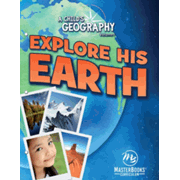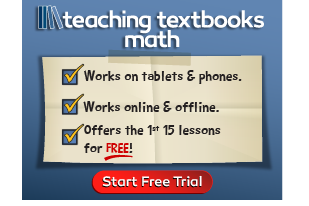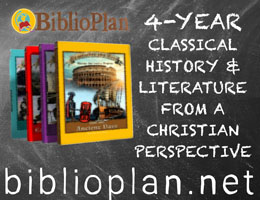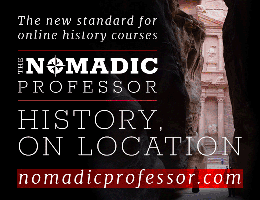Ann Voskamp wrote the first two books in A Child's Geography series, geography textbooks for children in grades one through six (grammar stage). Terri Johnson has written three additional volumes. Voskamp and Johnson both write with an engaging style, directly to the student:
While I could see your home from the street, you can't see the home God made for us by standing back a little. The home god made for us is much bigger than just what you see outside your window, bigger than what is down your street, bigger even than what is across your country. The home God made for is STUPENDOUSLY HUGE!! So huge, we can't really see it all! That sounds strange, doesn't it? (p. 16 Vol. 1).
You might have noticed the reference to God. This series is Christian in perspective, especially in the first two books. The Christian worldview shows up through the text material, the "Excursion" activities, and especially in the "Reaching Out to His World" activities in the first two books. The last three volumes are less visibly Christian. They each have an optional prayer guide, and there are occasional spots in the texts that are clearly written with an assumption that the audience is Christian.
Books are printed in full color on glossy paper, with photos, drawings, and other graphic elements contributing to outstanding visual presentation. Each book includes bonus downloadable content that has copywork passages, templates for students to use, tests, and other printable pages that vary by volume.
The first book has 11 lessons, while the other four books have 15 or 16 lessons. Depending upon how you schedule lessons, the first book might take up to 22 weeks to complete, a bit less than a full school year. This is fine for a subject that is intended to be supplemental at these grade levels. The other books take a bit more time and will likely take one school year to complete. Various scheduling options are described in the introduction to each book.
The books differ from each other enough that they need to be described separately.
Explore His Earth, Volume I
Explore His Earth (Volume I) has a total of 243 pages—168 in the book, the rest in the downloadable files. It is printed with a larger font than the second volume. The combination of the larger font and slightly fewer pages than the second volume results in significantly less lesson material (text) to be read with students. However, this volume has lots of "Too-Fun-to-Resist Excursions!"—two per lesson. These are mostly hands-on activities such as constructing a papier maché globe or conducting a relatively simple science experiment. These activities are especially good for children in the early to middle elementary grades who generally need more hands-on learning. Each lesson has a "Tell the folks at home all about it!" activity that is actually a narration. Prompting questions for the narrations are provided. In addition, for each lesson children create an oversize postcard using templates from the downloadable files. Postcard creation serves as a "notebooking" activity. These are to be collected together with a single ring for review and reference.
One of the important reasons to study geography is to understand other people and their cultures from God's perspective and to develop a loving concern for them. To that end, Voskamp includes a "Reaching Out to His World" activity at the end of each lesson. It discusses a topic such as homelessness, how earthquakes affect people's lives, and the activities of Mercy Ships, and then suggests prayer and/or actions in response. Additional resources such as books and videos are recommended under "For Further Exploration."
Copywork selections in the downloadable files include excerpts from the text, definitions, biblical quotes, poetry, and occasional quotes from other sources. Copywork forms are provided in four different formats to suit younger and older students and to allow the option of adding a drawing. Downloadable maps include both labeled and unlabeled versions. In addition, there is a "Tectonic Plate Puzzle" plus a quiz for each chapter.
This first volume, Explore His Earth, really lays the foundation for later geography studies, covering topics like the globe, the atmosphere, continents, oceans, seasons, weather, climate, the structure of the Earth, plate tectonics, earthquakes, volcanoes, latitude, and longitude.
Explore the Holy Land, Volume II
Explore the Holy Land (Volume II), co-authored by Tonia Peckover, shifts into more content and adds significant cultural studies as students learn about Turkey, Israel, Egypt, Iraq, Saudi Arabia, and Jordan. The study of each country is divided into two or three sections, so the material goes quite in-depth. Reading material even within each lesson is split into sections to keep it manageable. This volume uses "Field Notes" rather than "Tell the folks at home all about it!" for students to narrate what they have learned after each section of reading. Rather than postcards, students create a "Travel Log" with map work and notes from their studies. These should be collected in a notebook. A "Bringing it Home" section at the end of each lesson suggests resources for related art, music, and books, plus an occasional poem or recipe to try.
Culminating each group of lessons on a country is a "Go into all the world…" prayer for the people about whom the children have learned. You might have noticed that this volume lacks the "Excursions"—experiments and hands-on activities—of the first volume. While there are map work, narration, and drawing activities, as well as the occasional recipe to cook up, there's a definite shift toward a more "academic" approach.
This book has 192 pages plus another 87 in the downloadable files. The downloadable files have copywork, maps, and quizzes like those for Volume I. Instead of Postcard templates, it has Travel Log templates, again in four different versions. It also has the recipes that are in the book formatted in "recipe card" size for easy printing.
Explore The Classical World, Volume III
Explore the Classical World was written by Terri Johnson. As you would expect, her writing style differs somewhat from that of the first two volumes. Yet, there's a natural progression. As the second volume became more academic in tone, the third continues that progression while retaining a "conversational" writing style. Explore the Classical World presents more information on each topic than the first two books, but it does so in the fashion of a narrated travel log where the reader (or listener) is coming along for the ride. Because of both vocabulary and content, it is probably best for students in about fourth grade through middle school.
Explore the Classical World is a fascinating, modern-day geography and culture study of Greece, Italy, Macedonia, Albania, Montenegro, Serbia, Bosnia and Herzegovina, Croatia, Slovenia, and Malta, but it also brings in historical information from time to time. It would be ideal to complete this volume while studying Ancient Greece and Ancient Rome.
Chapters each include one or more section breaks that conclude with "Field Notes." Each Field Notes assignment addresses two or three topics from the section students have just read with one or more questions for each topic. Most of the questions are for comprehension, but a few ask for subjective responses. Responses are to be written in a notebook rather than used for oral narration.
The downloaded book includes web links, activities, recipes, extra reading suggestions, lists of timeline entries for each chapter, a country-by-country prayer guide (similar to the book Operation World), an 11" x 17" map of the classical world, "Travel Log" lists of map entries for students to add to maps, and both labeled and unlabeled maps to be used with the Travel Log or for other purposes.
Activities are sometimes links to websites for the actual activity instructions. Some are simple such as listening to a Sonata or watching a video about glass blowing, while others like painting a fresco, making a mosaic, creating a tourist brochure, or making an ancient Roman costume are much more involved. There are one or more activities from which to choose for all but chapter 14.
Recipes are included for most but not all chapters. Many of these are challenging—e.g., making Baklava—so the recipes definitely require parental assistance.
Explore Medieval Kingdoms, Volume IV
The fourth book continues the narrated travel log style of the third book, but this time exploring many of the European countries that come to mind when we think of the Middle Ages. We travel to Spain, Portugal, France, Switzerland, Austria, Germany, Belgium, the Netherlands, and a number of small kingdoms. While this is a modern-day travelog, Johnson inserts some history along the way, jumping back even to ancient times and sometimes revisiting events from the twentieth century.
While the entire series is intended for the elementary grades, I think this book is best for students in grades four through eight. It touches upon so many historical events and cultural experiences with which younger children are not likely to be familiar that they will probably find it difficult to follow along. On the other end, the reading could be of interest even for teens and adults interested in European countries, so it can easily serve students up through eighth grade, and maybe beyond.
Each section concludes with a set of questions that include some recall-type questions as well as some that require a personal response. Vocabulary words are printed in a bold font. These words are included in a glossary at the back of the book.
This is a printed book with additional downloadable files. The files include maps (both labeled and unlabeled), map activities, My Passport Travel Log (for creating a pretend passport), timeline events and pages, extra reading recommendations, authentic recipes, hands-on activities, and a prayer guide.
A Child's Geography Vol. 5: Explore Viking Realms
Explore Viking Realms ranges further than you might expect as it studies the entire area of northern Europe including the Baltic states, Scandinavia, the British, and Iceland. It focuses on the Middle Ages when the Vikings were an important force, influencing the cultures, geography, and government of many people.
Like the other printed books, it includes downloadable files with narration prompts, note booking activities, vocabulary work, and mapping activities. Recipes give students a taste of the cuisine from the various cultures, and hands-on activities help reinforce learning.
Summary
For all these books, younger students will need parents to read the text to them and discuss new or unfamiliar vocabulary. These are not written on a third or fourth-grade child's reading level. Older students might be able to read and complete some of their work independently, but narrations, activities, cooking, and experiments obviously require interaction with parents. These books should work best for a family that reads and works through the lessons together.
















